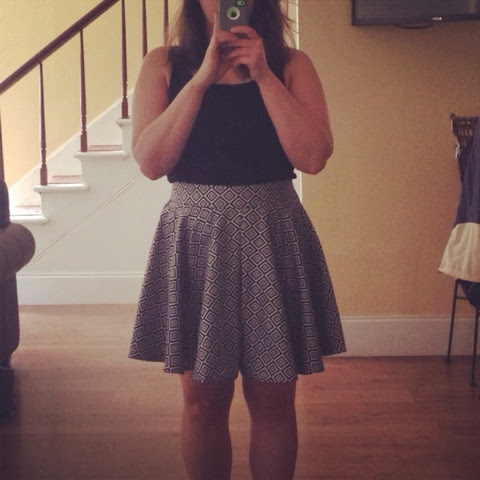I bought this pattern two years ago as a very novice seamstress. I originally made a FBA on the size 14 (wildly too large), made a straight 14 that I rarely wore (still too large), eventually did a FBA on size 10 (darts too restrictive) and then finally chucked the pattern.
My recent success with my Hazel bodice got me thinking: perhaps I had approached the Peony pattern from the beginning all wrong. Perhaps instead of trying to make the 10 or 14 work (just like I had done with Hazel), I should start with the 12 and go from there.
As luck, or the sewing fairies, would have it, I fit perfectly into the size 12 bodice. Gasp!
I spent a lot of time in the mirror analyzing this bodice.
Surely I am imagining things. Surely I am missing a wrinkle or pulling. Surely these darts need some manipulating.
Nope. Nada. Nothing of the sort.
Now, to be fair, I will gladly admit my perfectionism. I took the 12, removed 1" of length for my short waist, and did a tiny 1/4" FBA for what I call "singing room."
As you can see, there's not a ton of difference, except I can take a slightly fuller breath in the latter, and I feel better about the length and fullness adjustments.
This leads to an interesting thought: how many times do seamstresses overthink the obvious and wind up frustrated and confused?
In my defense, it was only after making 10 size 12 Laurel dresses that the idea occurred to me that I had been choosing the wrong size in all Colette patterns. But two years!?! I have wasted two years not sewing the Peony pattern!
Some additional thoughts: perhaps muslins in three sizes (high bust, full bust and the one in between) are helpful to construct. Yes, this is a ton of muslin making, but let's take the Emery dress as an example:
 | |
| Photo courtesy of www.christinehaynes.com |
- Based on the size chart, I fall between the 14 and 16 based on my full bust.
- Based on the finished measurements, I should pick the 14 bust and 12 waist.
- Based on my high bust, I should be a size 10.
My muslin of the 14 bust/12 waist/14 sleeve looks nice - there's enough room for everything - but it's a smidge too large. I also did a muslin of the size 10 bust/12 waist with an FBA - twice - and it looks wildly off base, plus the sleeve is too tight.
After my epiphany, I'm wondering now if the 12 + 3/4" FBA isn't the answer to the perfect fit. But seriously, how many muslins is too many? I've already made 3, none of which are perfect but now I'm 99% convinced the 12 is the way to go, AND it will provide a happy medium in sleeve fit as well.
Big 4 patterns I understand more easily - I always make a size 16 bust + 18 waist and check the finished measurements, adding an FBA if needed, OR stick to the patterns with cup sizes.
Indie patterns, though, have me rethinking my entire system. Perhaps the answer is the simplest: compare measurements with finished measurements, and choose the size in the middle.
Have you had a conundrum like this? How did you handle it?

















































